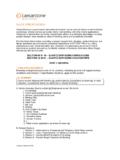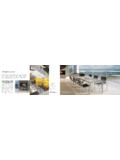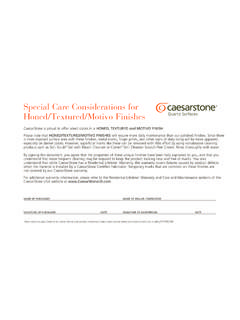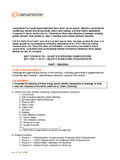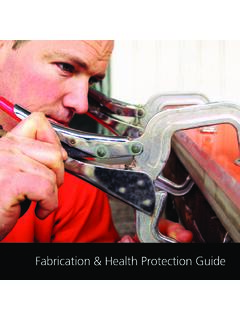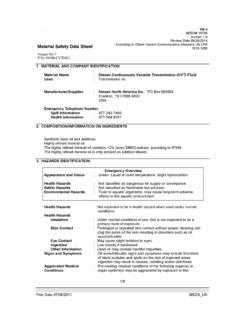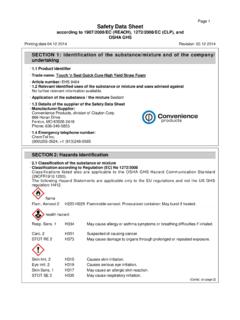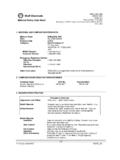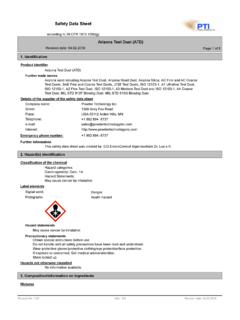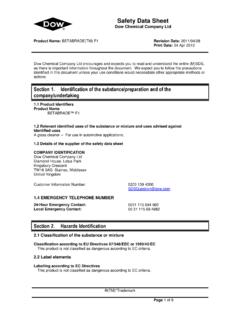Transcription of SAFETY DATA SHEET - Caesarstone
1 SAFETY data SHEET Product Name: Caesarstone / Concetto MSDS Date: March 26th, 2012 1. PRODUCT AND COMPANY IDENTIFICATION Product Name: Caesarstone / Concetto Product Use: Caesarstone Quartz Surfacing and Concetto Natural Stone Surfacing Company: Caesarstone Kibbutz Sdot-Yam MP Menashe, 38805 Israel Emergency Phone Number: 972-4-6364-555 2. COMPOSITION/INFORMATION ON INGREDIENTS Material CAS Number % Crystalline Silica and other natural stone 14808-60-7 >85 Cristobalite 14464-46-1 <50 Polymeric resin 7-15 Additives 0-8 3. HAZARDS IDENTIFICATION Emergency Overview Information Pertaining to Particular Dangers for Man and Environment: Classification: This preparation is not classified as hazardous according to the latest adaptation of European Union Directives 67/548/EEC and 1995/45/EC. SAFETY data SHEET Potential Health Effects Quartz surfaces products are not hazardous as shipped. However, operations such as sawing, grinding, routing, drilling and sanding can generate dust.
2 Inhalation of such dusts, smoke and vapors may cause upper respiratory tract irritation. Symptoms may include burning sensation, coughing, sneezing, and sore throat. Skin contact with dust may produce transitory mechanical irritation. Symptoms may include redness and itching. High concentrations of dusts may cause irritation to the eyes causing burning, redness, and tearing. This product is not expected to be toxic if ingested. Overexposure to airborne crystalline silica can cause silicosis, a chronic and progressively debilitating disease, characterized by the formation of silica-containing scar tissue in the lungs. Symptoms of silicosis include coughing, difficulty breathing, wheezing and progressive impairment of lung function. In addition to silicosis, epidemiology studies show limited evidence of an excess of lung cancer in occupations involving exposures to crystalline silica, such as stone cutters and granite industry workers.
3 Individuals with chronic respiratory disorders may be adversely affected by any fume or airborne particulate matter exposure. Persons with preexisting skin disorders may be more susceptible to the effects of this material. Carcinogenicity Information The following components are listed by IARC, NTP, OSHA or ACGIH as carcinogens. Material IARC NTP OSHA ACGIH Silica, Crystalline (quartz and cristobalite) 1 X yes A2 4. FIRST AID MEASURES Eye Contact: Flush immediately with copious amounts of water for a minimum of 15 minutes. Seek immediate medical attention. Skin Contact: Wash affected area with soap and plenty of water. Seek medical attention if adverse effect occurs. SAFETY data SHEET Inhalation: Remove person to fresh air. If breathing is difficult, or has stopped, administer artificial respiration (mouth-to-mouth) or oxygen as indicated. Call a physician. Ingestion: Product in its marketed form is inert. If large amounts are swallowed, seek medical attention or advice.
4 5. FIRE FIGHTING MEASURES Auto ignition: Quartz surfaces products can be combusted only with difficulty. Fire Spreading Rating: 5 Smoke Developed Rating: 25 Flash Point: 490oC Flammable Limits in Air (% by Volume): NA Extinguishing Media: Water, Dry Chemical, CO2 and Foam. Special Fire Fighting Procedures: Keep personnel away and upwind of fire. Use self-contained breathing apparatus with full face mask. Unusual Fire and Explosion Hazards: Decomposition products resulting from the polymer and pigments degrading at elevated temperatures include various hydrocarbons, carbon dioxide, carbon monoxide and water. Fumes of metal oxides and mica particles could also be released. 6. ACCIDENTAL RELEASE MEASURES Cleanup and Disposal of Spill: Solid slabs can simply be gathered and disposed of as necessary. If large amounts of dust or wastes are created by cutting process, vacuum or sweep up material avoiding dust generation or dampen spilled material with water to avoid airborne dust.
5 Wear suitable respiratory protection and protective clothing where necessary. If large quantities of this material enter the waterways contact the Environmental Protection Authority, or local Waste Management Authority. Dispose of waste in accordance with local, state and federal regulation. SAFETY data SHEET 7. HANDLING AND STORAGE Handling/Storage: Avoid breathing dust. Wash hands before eating, drinking, smoking, or using toilet facilities. Wash thoroughly after work using soap and water. Good industrial hygiene practices should be followed when handling this material. Product is heavy and breakable; handle with care to avoid injury and prevent damage. 8. EXPOSURE CONTROLS / PERSONAL PROTECTION Exposure Guidelines: Reference Substance Guideline or limit (mg/m3) OSHA (29 CFR Z-3) OSHA Vacated PELs Respirable crystalline silica: quartz, cristobalite, and triymite Total dust, (30 mg/m3 / % SiO2 + 2); Respirable dust, (10 mg/m3 / % SiO2 + 2) as 8hr TWA s mg/m3 TWA (respirable dust) ACGIH (2010) Respirable crystalline silica: quartz, cristobalite, and triymite mg/m3 (8hr TWA) NIOSH Respirable crystalline silica: quartz, cristobalite, and triymite mg/m3 (8hr TWA) Abbreviations: TWA = time-weighted average, ACGIH = American Conference of Governmental Industrial Hygienists, Inc.
6 OSHA=Occupational SAFETY and Health Administration, NIOSH=National Institute of Occupational SAFETY and Health. Engineered Controls: Ventilation must be adequate to maintain the ambient workplace atmosphere below the exposure limit(s) outlined in the MSDS. General room ventilation is satisfactory under anticipated use conditions. Generally, machinery and tools involving the use of water are required. PERSONAL PROTECTIVE EQUIPMENT Eye/Face Protection: If eye contact while using this product may be anticipated, wear appropriate SAFETY glasses with side shields or chemical goggles as described by OSHA's eye and face protection regulations in 29 CFR or European Standard EN166. Respiratory Protection: Respiratory equipment approved by NIOSH/MSHA for protection against organic vapors and dusts is necessary to avoid inhalation of excessive air contaminants. The appropriate respirator selection depends on the type and magnitude of SAFETY data SHEET exposure (refer to 29 CFR for appropriate NIOSH approved respirators and to the NIOSH Pocket Guide to Chemical Hazards, DHHS (NIOSH) Publication NO.)
7 2001-145 for equipment selection). Use a positive pressure air supplied respirator if there is a potential for an uncontrolled release, exposure levels are not known or under any other circumstances where air purifying respirators may not provide adequate protection. Skin Protection: During cutting, grinding or sanding operations use body protection appropriate for task including work gloves if handling sharp or rough edges and steel-toed shoes if lifting product. PREVENTION P260 - Do not breathe dust generated in the cutting, grinding and polishing processes. P264 - Wash face and hands thoroughly after handling. P270 - Do not eat, drink or smoke when using this product. P284 - Wear respiratory protection for particles (P3). FIRST AID MEASURES P314 - Get medical advice/attention if you feel unwell. P501 - Dispose of remains in accordance with local regulation. R20 - Harmful by inhalation R48 - Danger of serious damage to health by prolonged exposure.
8 HYGIENE S22 - Do not breathe the dust. S38 - Use personal protective equipment P3. Classification according to directive 1999/45/EC 9. PHYSICAL AND CHEMICAL PROPERTIES Physical Appearance: Multi-colored engineered stone Odor: Odorless pH: NA Specific Gravity: Water Solubility: Insoluble Flash Point: 490oC Melting Point: NA SAFETY data SHEET Boiling Point: NA Vapor Pressure: NA % Volatiles: NA Viscosity: NA 10. STABILITY AND REACTIVITY Chemical Stability: Stable at normal temperatures and storage conditions. Incompatibility with Other Materials: This product is incompatible with hydrofluoric acid. Hazardous Decomposition Products: Thermal decomposition can release various hydrocarbons, carbon dioxide, carbon monoxide and water. Fumes of metal oxides and mica particles could also be released. Hazardous Polymerization: Will not occur 11. TOXICOLOGICAL INFORMATION Acute Effects Crystalline Silica: Inhalation (human) LCLo: Inhalation (human) TCLo: 16mppcf/8H/17,9Y Intermittent; focal fibrosis, (pneumoconiosis), cough, dysponea.
9 Inhalation (rat) TCLo: 50mg/m3/6H/71W Intermittent; liver tumors Oral LD50 RAT: 500 mg/kg Chronic Effects Crystalline Silica Silicosis: caused by the inhalation and retention of respirable crystalline silica dust. Carcinogenicity: The International Agency for Research on Cancer (IARC) concluded that crystalline silica inhaled in the form of quartz or cristobalite from occupational sources is carcinogenic to humans (Group 1). The National Toxicology Program (NTP), in its Ninth Annual Report on Carcinogens, concluded that silica, crystalline (respirable) is known to be a carcinogen, based on sufficient evidence in experimental animals and in humans. The SAFETY data SHEET Occupational SAFETY and Health Administration (OSHA) does regulate crystalline silica (quartz) as a carcinogen. The American Conference of Governmental Industrial Hygienist (ACGIH), noted in the "TLV & BEIs" book, version of 2011, that silica, crystalline (respirable) and cristobalite is A2 (Suspected Human Carcinogen - human data are accepted as adequate in quality but are conflicting or insufficient to classify the agent as a confirmed human carcinogen).
10 The American Thoracic Society position on the issue of silica carcinogenicity was published in Adverse Effects of Crystalline Silica Exposure, American Journal of Respiratory and Critical Care Medicine, Vol. 155, pp. 761-765 (1997). The official statement concluded that The available data support the conclusion that silicosis produces increased risk for bronchogenic carcinoma. The cancer risk may also be increased by smoking and other carcinogens in the workplace. Aggravation of Pre-existing Conditions: Inhalation may increase the progression of tuberculosis; susceptibility is apparently not increased. Persons with impaired respiratory function may be more susceptible to the effects of this substance. Smoking can increase the risk of lung injury. Mutagenicity: No data Reproductive Effects: No data Developmental Effects: No data 12. ECOLOGICAL INFORMATION Toxicity is expected to be low based on insolubility in water. Environmental Fate: ND Environmental Toxicity: ND ISO 14001 Certification: Caesarstone is ISO 14001 certified for Environmental Management Systems.
